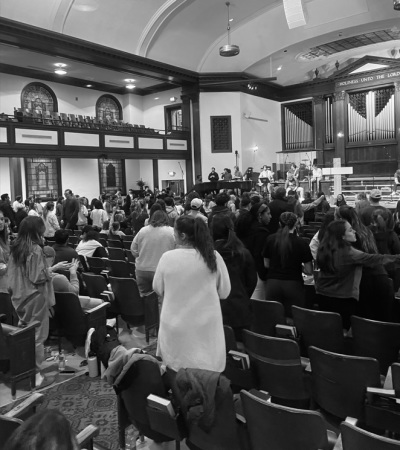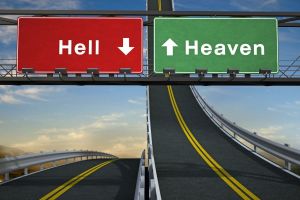Asbury revival – My reflection 1 year later

Evangelicals have prayed for revival in America for decades. But do we know what to do when it happens?
It’s been nearly one year since the revival at Asbury University in central Kentucky began on February 8, 2023. The widely publicized revival brought 50,000-70,000 people to Wilmore, Kentucky, population 6,000, overwhelming the infrastructure of a small community. Sadly, school authorities were obligated to shut it down after nearly continuous worship, night and day, across over two weeks. It began in the university auditorium after a routine chapel service when students declined to leave, gaining national attention, and attracting visitors from around the world.
Asbury Theological Seminary across the street, a separate institution with common Methodist Holiness roots, opened its own chapel, auditorium, and gymnasium to accommodate the crowds. At one point, the main road into crowded Wilmore was closed to traffic. The worship was Methodist in spirit, which means simple, earnest, and non-flamboyant. Students and other worshippers sang hymns, prayed, shared testimonies, and confessed sins.
One Asbury Seminary professor recounted his brief visit to the university auditorium, citing a great sense of serenity. He could have stayed for hours, he said. But like the woman healed by the mere touch of Jesus’s garment, as he described it, he felt whole and left contentedly after 90 minutes.
I was in Wilmore not long after the revival, attending the Wesleyan Theological Society. The revival’s embers were still warmly felt, and everyone spoke of it glowingly. The seminary president recounted that a Malaysian seminary student at Asbury had prayed for years for revival. Back in Malaysia, he sensed he should return to Wilmore, and in the Singapore airport, he first learned of the revival. He surprised many when he entered the Asbury auditorium.
Wilmore is about sixty miles from Cane Ridge, a highpoint of the Second Great Awakening, originally hosted by Presbyterian clergy but attracting Methodists and Baptists, spawning the Restoration Movement now known as the Churches of Christ and Disciples of Christ. For a week, thousands worshipped amid shouts, groans, and falling to the ground in ecstasy over salvation or mortification over sin.
There was no equivalent drama at the Asbury Revival. The singing, prayers and testimonies were measured. The worship remained student-led, but professors were often on the sidelines to assist, at times discouraging older people and visitors from taking center stage. There was no giant screen, pyrotechnics, or choreography. Other than electricity, heat and indoor plumbing, the technology for the Asbury Seminary was not much more advanced than at Cane Ridge 223 years ago.
But the tone at Asbury was decidedly less emotive, which makes a Wall Street Journal critique a little odd.
D.G. Hart recalled Mercersburg Seminary’s John Williamson Nevin, whose 1843 “The Anxious Bench” critiqued Charles Finney’s revivalism. Amid public hoopla, conversions could be faked, Nevin’s fretted. “What you see in a revival, he suggested, isn’t necessarily what you get,” Hart noted, asking. “Revivalism may produce some good, too, but can it be a mass vehicle for spiritual exhibitionism? Probably.”
Hart also asked if the “emotional highs of revivals” can “endure the disappointments of life?” Perhaps, echoing Nevins, “slow, steady growth in faith…is a more reliable path to Christian maturity?” Hart lamented: “The most fervent proponents of revivalism won’t appreciate these queries.”
Few if any at Asbury or in the wider Methodist world would resent these questions. Asbury Revival participants typically report encouragement and peace, not “emotional highs.” Students from many Christian backgrounds attend Asbury University and Asbury Seminary. But both emerged from the Wesleyan Holiness movement, which emphasized the primacy of sanctification and perfection in Methodist spirituality.
For Wesleyan Holiness people, conversion, with or without “emotional highs,” is only the start of a Holy Spirit-led journey to greater closeness with God. John Wesley had his celebrated “conversion” at a Moravian meeting on Aldersgate Street in London, listening to Martin Luther‘s Preface to the Epistle to the Romans. Wesley’s heart was “strangely warmed,” as he recalled: “I felt I did trust in Christ, Christ alone, for salvation; and an assurance was given me that he had taken away my sins, even mine, and saved me from the law of sin and death.”
For Wesley and his theology, God worked through heart and head. Wesleyan spirituality is not so much about emotional highs but steady, methodical perseverance through divine grace. Any spirituality, even if practiced alone, can be faked. But Methodism, like all major Christian traditions, knows God sees the heart.
Hart, in his mild critique, accurately noted the Asbury Revival pleased many evangelicals for attracting favorable publicity, even from The New York Times. It also offered a counternarrative to supposedly relentless secularization. Anecdotally, the spirit of the Asbury Revival over the last year has spread globally through its many international participants, besides throughout the U.S. Hopefully a social scientist someday will try to quantify it. Likely decades from now we will learn of new churches, and perhaps even new denominations or communities, that arose from the revival.
The Asbury Revival was a needed reminder that God often has surprises, and His redemptive work continues. Most of God’s redemptive work doesn’t occur dramatically at large public events. Mostly it unfolds quietly in the lives of believers. But occasional large, public outpourings are helpful reminders of the Gospel’s power.
Originally published at Juicy Ecumenism.
Mark Tooley became president of the Institute on Religion and Democracy (IRD) in 2009. He joined IRD in 1994 to found its United Methodist committee (UMAction). He is also editor of IRD’s foreign policy and national security journal, Providence.




























